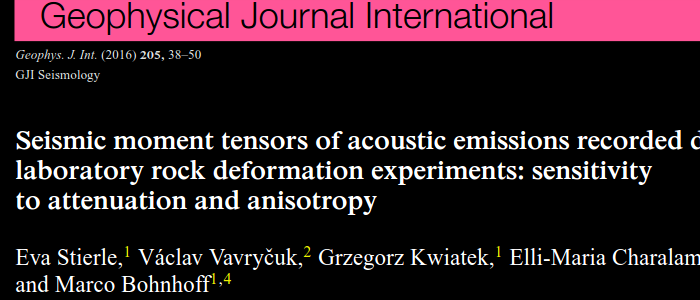We have published a paper related to the analysis of seismic moment tensors of acoustic emission data with a special focus on effects of rock anisotropy on resulting moment tensors.
Stierle, E., V. Vavryčuk, G. Kwiatek, E.-M. Charalampidou, and M. Bohnhoff (2016). Seismic moment tensors of acoustic emissions recorded during laboratory rock deformation experiments: sensitivity to attenuation and anisotropy, Geophysical Journal International 205, no. 1, 38–50, doi 10.1093/gji/ggw009.
AbstractSeismic moment tensors can provide information on the size and orientation of fractures producing acoustic emissions (AEs) and on the stress conditions in the sample. The moment tensor inversion of AEs is, however, a demanding procedure requiring carefully calibrated sensors and accurate knowledge of the velocity model. In field observations, the velocity model is usually isotropic and time independent. In laboratory experiments, the velocity is often anisotropic and time dependent and attenuation might be significant due to opening or closure of microcracks in the sample during loading. In this paper, we study the sensitivity of the moment tensor inversion to anisotropy of P-wave velocities and attenuation. We show that retrieved moment tensors critically depend on anisotropy and attenuation and their neglect can lead to misinterpretations of the source mechanisms. The accuracy of the inversion also depends on the fracturing mode of AEs: tensile events are more sensitive to P-wave anisotropy and attenuation than shear events. We show that geometry of faulting in anisotropic rocks should be studied using the source tensors, since the P- and T-axes of the moment tensors are affected by velocity anisotropy and deviate from the true orientation of faulting. The stronger the anisotropy is, the larger the deviations are. Finally, we prove that the moment tensor inversion applied to a large dataset of AEs can be utilized to provide information on the attenuation parameters of the rock sample. The method is capable of measuring anisotropic attenuation in the sample and allows for detection of dilatant cracking according to the stress regime.
